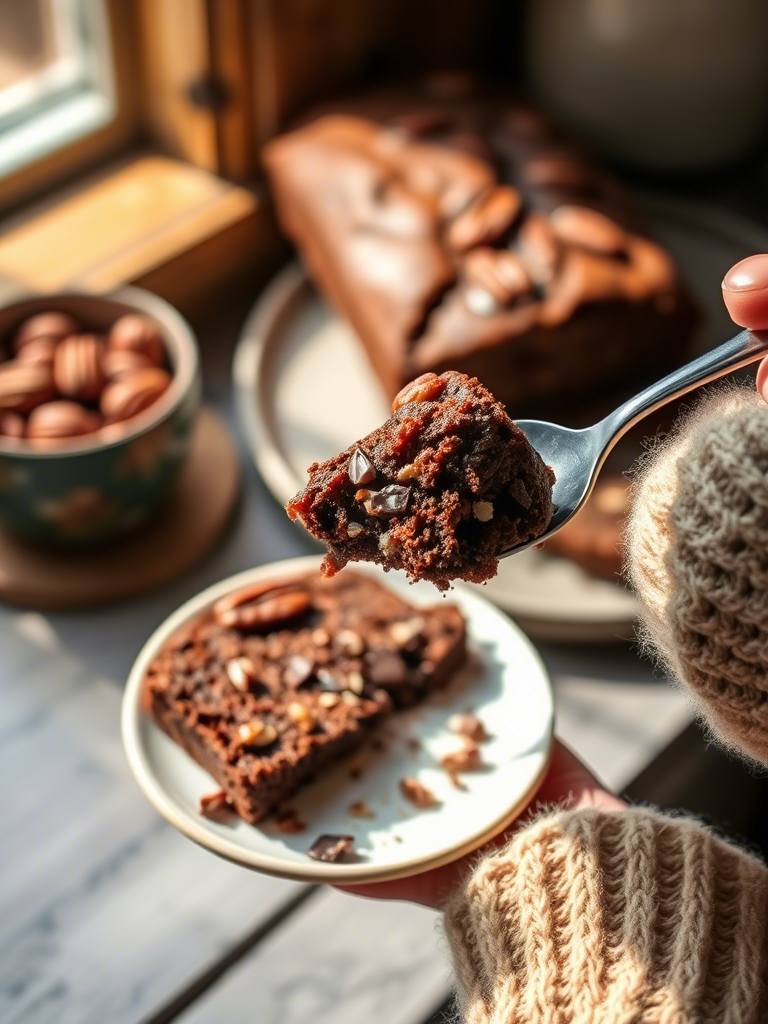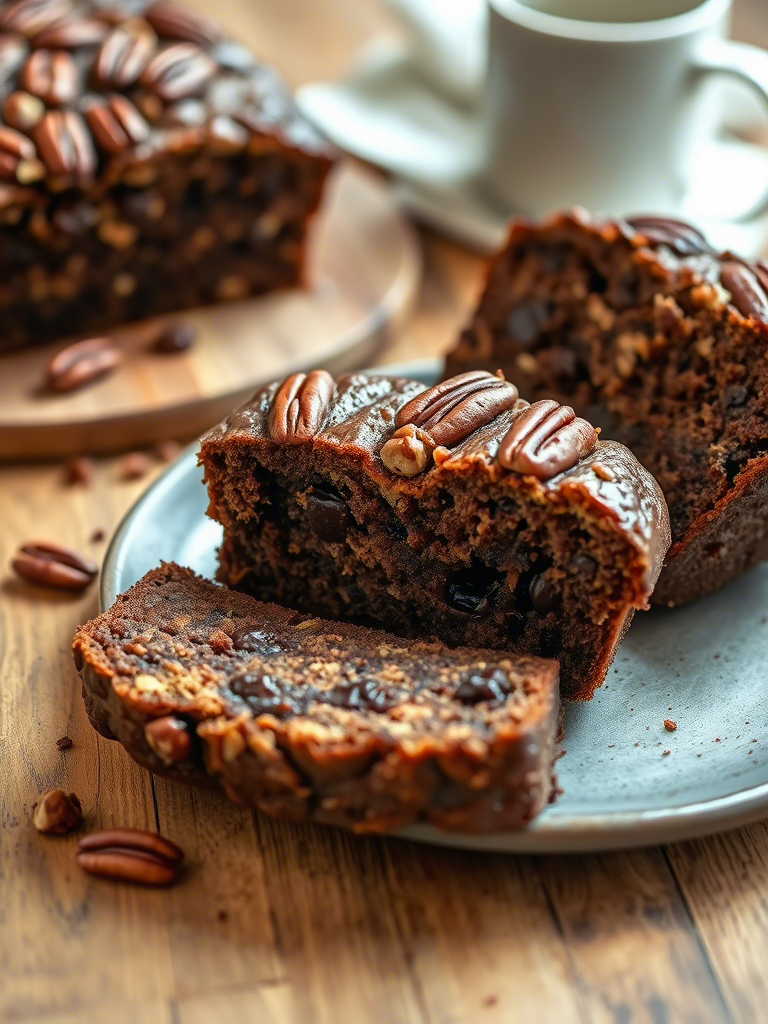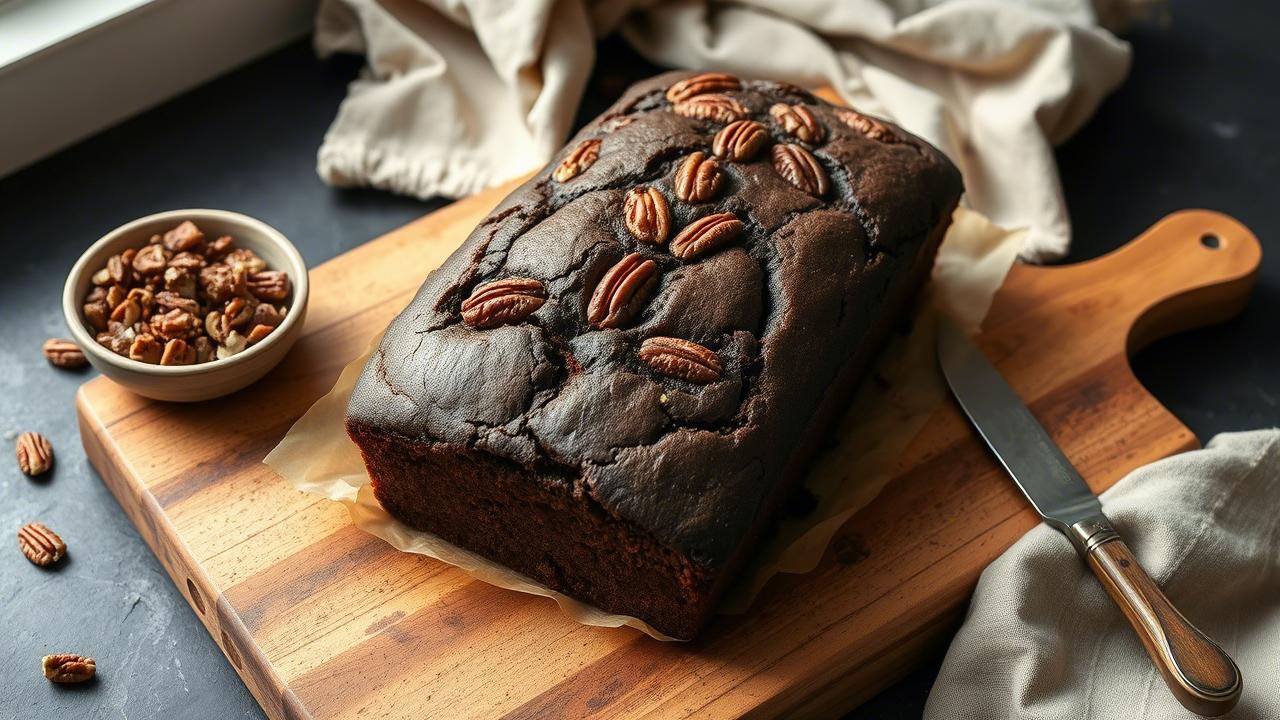There’s something oddly magnetic about the smell of brownies baking, but turn that idea sideways and you get pecan brownie bread—a loaf that’s dense yet sliceable, fudgy yet structured. It’s not just a dessert pretending to be bread. It’s a hybrid that demands both pastry precision and bread-baking intuition. Many people treat it like a novelty, but it’s really a masterclass in balancing texture, fat, and flavor. If you’ve only eaten brownies from a pan, you’re missing the kind of satisfaction that comes from cutting into a warm loaf, the knife gliding through a soft crumb interrupted by crunchy pecan pockets.
Understanding What Pecan Brownie Bread Really Is
At its core, pecan brownie bread is a brownie batter baked in loaf form, but that’s oversimplifying. The loaf shape means the bake time is longer, and with that comes changes in structure. The edges don’t crisp up like they do in a flat pan; instead, you get an even tenderness throughout. The pecans aren’t just sprinkled on top; they’re folded in, which means you have to think about nut distribution so they don’t all sink to the bottom.
Many professional bakers approach this like a tea cake, not a brownie. That means controlling moisture content, using the right proportion of eggs for structure, and making sure cocoa doesn’t overpower the toasted pecan flavor. I’ve seen chefs ruin this by overbaking “to be safe,” which only gets you a dry, chocolate-flavored brick. The magic is in baking just until the center sets—no more, no less.
Ingredient Quality Matters More Here Than You Think
In brownies, chocolate is king, but in pecan brownie bread, it’s a co-star. If your chocolate is too sweet, you drown out the earthiness of the pecans. Go for a 60–70% cocoa chocolate—good enough to eat on its own. Unsweetened cocoa powder (Dutch-processed) deepens flavor without making the loaf bitter.
Now, the pecans. They should never go in raw. A quick toast—about 7 minutes in a 350°F oven—wakes up their oils and turns “meh” nuts into aromatic, almost buttery treasures. You can chop them small for more even distribution, or leave some halves if you want dramatic slices where a whole pecan cuts through the crumb.
Butter is your friend here, but it’s easy to underestimate its role. Melted butter gives you density, while creamed butter introduces air. I prefer melted for a fudgier loaf. Some bakers mix in a tablespoon or two of neutral oil for extra tenderness, which isn’t cheating—it’s science.

The Balancing Act: Sugar, Eggs, and Structure
Sugar doesn’t just sweeten—it binds moisture, helps with crust formation, and plays a role in chewiness. For loaf brownies, I reduce sugar slightly compared to pan brownies because the slower bake already promotes caramelization. Too much sugar here and you’ll get a gummy middle.
Eggs are the quiet architects. Two large eggs usually suffice for a standard loaf, but adding an extra yolk boosts richness without making the bread too eggy. Whisking until just combined is key—overmix and you’ll start building gluten, which is not your friend in a tender loaf.
Flour is minimal here—about ¾ to 1 cup for most recipes—and should be sifted. I’ve tested loaves with bread flour, but the higher protein count gave me a chewy, bread-like texture, which works if you want sturdiness for slicing, but loses the melt-in-your-mouth feel most people expect.
The Technique That Separates Good from Great
Brownie bread is not a “dump and stir” situation if you want it bakery-level. Melt chocolate and butter gently—either over a bain-marie or in short microwave bursts. Whisk sugar in while still warm to help dissolve granules, giving a smoother crumb. Add eggs one at a time, fully incorporating before adding the next.
Fold in dry ingredients with a spatula, not a whisk, and stop as soon as streaks disappear. Pecans should be tossed lightly in a tablespoon of flour before folding in. This tiny step keeps them suspended instead of sinking.
For baking, a standard 9×5 loaf pan works, but line it with parchment to prevent sticking and make removal stress-free. Bake at 325°F to ensure even cooking—loaf form traps more heat, so high temps can scorch edges before the center sets. You’re looking for a slight jiggle in the middle; residual heat will finish the job.

Flavor Variations That Work
Pecan brownie bread is versatile enough to take on flavor twists without losing its soul. Espresso powder (just a teaspoon) intensifies chocolate without tasting like coffee. A splash of bourbon pairs beautifully with the nuttiness.
For a slightly more rustic profile, swap half the pecans for walnuts, or add a tablespoon of blackstrap molasses for depth. Cinnamon might sound odd, but in small doses it warms the chocolate and pecan notes in a way that feels almost autumnal.
Common Pitfalls and How to Avoid Them
One of the biggest mistakes? Overmixing after adding flour. This builds gluten and leads to a loaf that’s more like a dense sponge cake. The other is overbaking—professionals use an instant-read thermometer, pulling the loaf at 195°F in the center for optimal fudginess.
Also, be mindful of storage. The loaf’s moisture means it can go stale faster than a pan brownie. Wrap in parchment, then foil, and store at room temp for 3 days max. Refrigeration tends to firm it up too much, so if you must, let it come to room temp before serving.
Serving Suggestions for Maximum Appeal
Warm slices with a smear of salted butter might sound decadent, but it’s an underrated way to enjoy this bread. For plated desserts, a thin slice with a quenelle of vanilla ice cream and a drizzle of warm caramel makes it restaurant-worthy.
For brunch service, consider serving it as mini loaves or thick slices alongside fresh berries. The slight bitterness of blackberries or raspberries cuts the richness beautifully.
The Professional’s Recipe for Pecan Brownie Bread
Ingredients:
1 cup (170g) semisweet chocolate, chopped
½ cup (113g) unsalted butter
1 ¼ cups (250g) granulated sugar
2 large eggs + 1 extra yolk
1 tsp vanilla extract
¾ cup (95g) all-purpose flour, sifted
¼ cup (25g) Dutch-processed cocoa powder
½ tsp salt
1 tsp espresso powder (optional)
1 cup (110g) pecans, toasted and chopped
1–2 tbsp neutral oil (optional, for extra tenderness)
Method:
- Preheat oven to 325°F. Line a 9×5 loaf pan with parchment.
- Melt chocolate and butter together until smooth. Stir in sugar while still warm.
- Whisk in eggs and yolk one at a time, followed by vanilla.
- In a separate bowl, combine flour, cocoa, salt, and espresso powder. Fold gently into wet mix.
- Toss pecans in 1 tbsp flour, then fold into batter.
- Pour into loaf pan, smoothing top. Bake 50–60 minutes, until center reads 195°F or toothpick has a few moist crumbs.
- Cool in pan 15 minutes, then transfer to wire rack.
Why This Recipe Works
This method avoids overmixing, keeps nuts suspended, and balances moisture with structure. The lower baking temp ensures a custardy interior without burnt edges. The extra yolk boosts richness, while espresso and Dutch cocoa deepen the chocolate base without overwhelming the pecan flavor.
Final Thoughts
Pecan brownie bread might not be as common as classic brownies, but in professional baking circles, it’s a quiet favorite. It’s the kind of recipe that rewards attention to detail, ingredient quality, and restraint. When made right, it slices cleanly yet melts on the tongue, giving you the best of both worlds—dessert and comfort loaf in one.
The beauty is, once you master the fundamentals, you can riff endlessly. Change the nuts, swap the chocolate type, even marble in a cream cheese layer. But always, always respect the bake time. That’s the line between “just okay” and “unforgettable.”
FAQs About Pecan Brownie Bread
What is pecan brownie bread?
A loaf-style dessert combining the texture of bread and richness of brownies, filled with pecans.
Can I use walnuts instead of pecans?
Yes, but the flavor will be slightly less sweet and more earthy.
How do I know it’s done baking?
When the top is cracked and center jiggles slightly—it’ll firm up as it cools.
Can I make it gluten-free?
Yes, with a good 1:1 gluten-free flour blend—avoid almond flour on its own.
Why toast the pecans?
To deepen flavor and prevent raw, waxy texture inside the bread.
Can this be frozen?
Absolutely—slice, wrap well, and freeze up to 3 months.
What cocoa powder should I use?
Dutch-process cocoa for smoother flavor and better structure.
Can I frost pecan brownie bread?
Technically yes, but it’s best left naked or with a simple glaze.
Do I need to refrigerate it?
Not for 3 days—but it lasts longer if chilled and wrapped.
Why did my bread sink in the middle?
Could be underbaked, too much leavener, or batter was overmixed.

Mariana is a passionate home cook who creates delicious, easy-to-follow recipes for busy people. From energizing breakfasts to satisfying dinners and indulgent desserts, her dishes are designed to fuel both your body and hustle.
When she’s not in the kitchen, she’s exploring new flavors and dreaming up her next recipe to share with the Foodie Hustle community.

